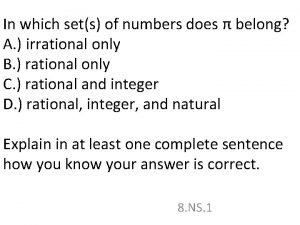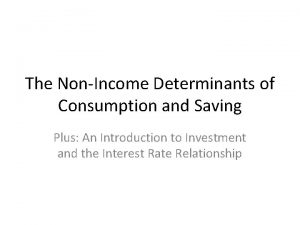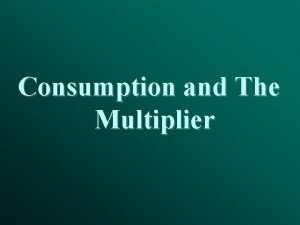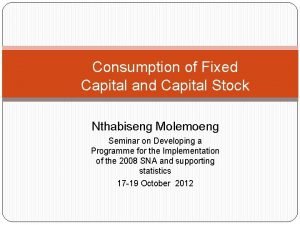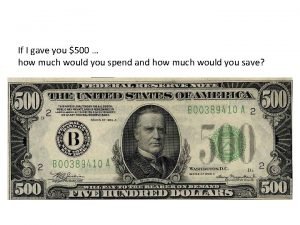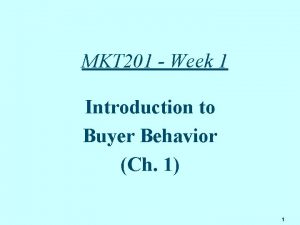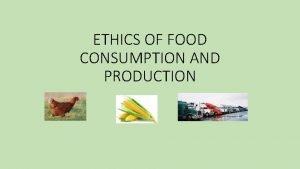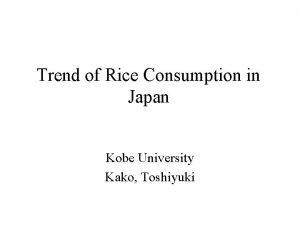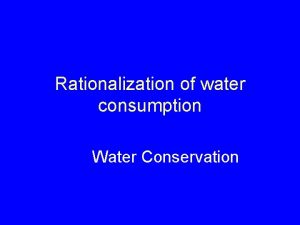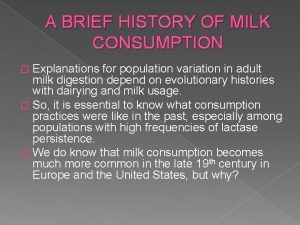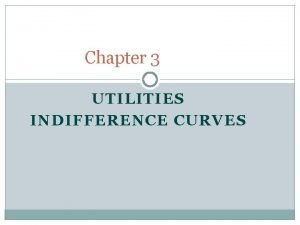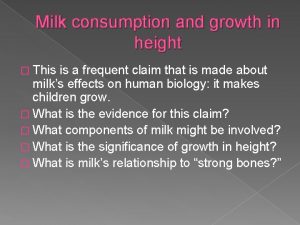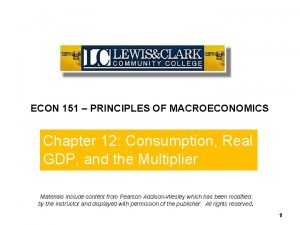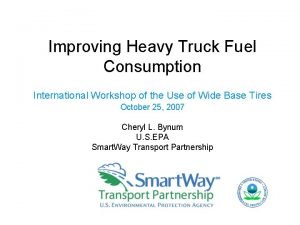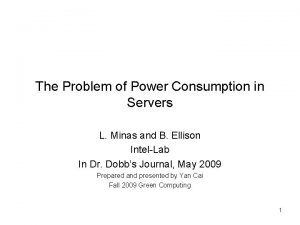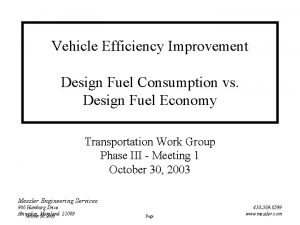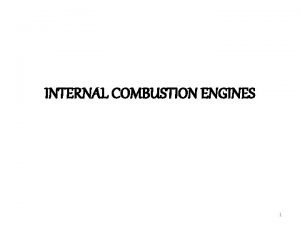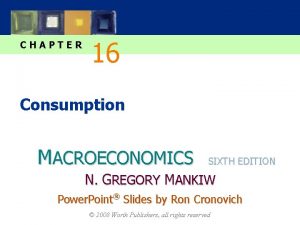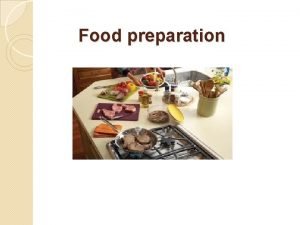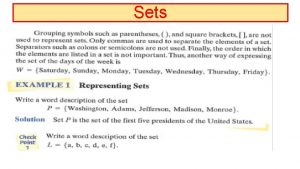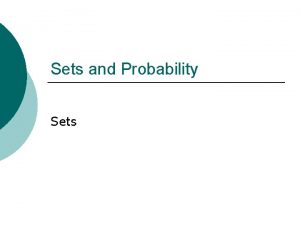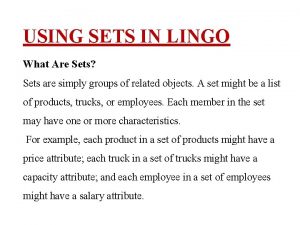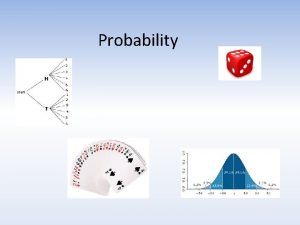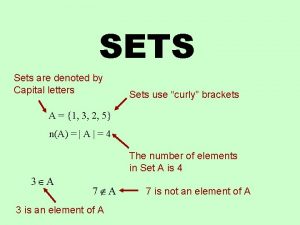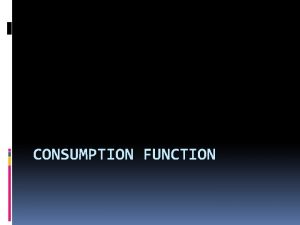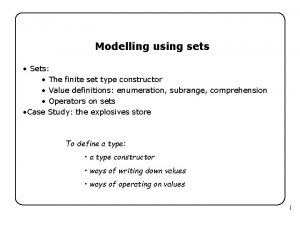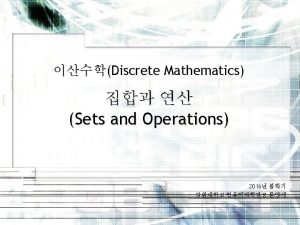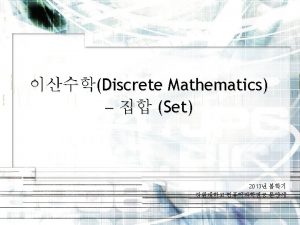Consumption Choice Sets u A consumption choice set




























































- Slides: 60

Consumption Choice Sets u. A consumption choice set is the collection of all consumption choices available/feasible to the consumer. u What constrains consumption choice? – Budgetary, time and other resource limitations.

Budget Constraints u. A consumption bundle containing x 1 units of commodity 1, x 2 units of commodity 2 and so on up to xn units of commodity n is denoted by the vector (x 1, x 2, … , xn) u Commodity prices are p 1, p 2, … , pn

Budget Constraints u Q: When is a bundle (x 1, … , xn) affordable at prices p 1, … , pn? u A: When p 1 x 1 + … + p n x n £ m where m is the consumer’s (disposable) income.

Budget Constraints u The bundles that are only just affordable form the consumer’s budget constraint. This is the set { (x 1, …, xn) | x 1 ³ 0, …, xn ³ 0 and p 1 x 1 + … + p n x n = m }

Budget Constraints u The consumer’s budget set is the set of all affordable bundles; B(p 1, … , pn, m) = { (x 1, … , xn) | x 1 ³ 0, … , xn ³ 0 and p 1 x 1 + … + p n x n £ m } u The budget constraint is the upper boundary of the budget set.

Budget Constraint for n=2 x 2 m /p 2 Budget constraint is p 1 x 1 + p 2 x 2 = m m /p 1 x 1

Budget Constraint for n=2 x 2 m /p 2 Budget constraint is p 1 x 1 + p 2 x 2 = m. Not affordable Just affordable More than affordable m /p 1 x 1

Budget Set for n=2 x 2 m /p 2 Budget constraint is p 1 x 1 + p 2 x 2 = m the collection of all affordable bundles. Budget Set m /p 1 x 1

Slope of the Budget Constraint x 2 m /p 2 p 1 x 1 + p 2 x 2 = m is x 2 = -(p 1/p 2)x 1 + m/p 2 so slope is -p 1/p 2 Budget Set m /p 1 x 1

Budget Constraints for n=3 u If n = 3 what do the budget constraint and the budget set look like?

Budget Constraint for n=3 x 2 m /p 2 p 1 x 1 + p 2 x 2 + p 3 x 3 = m x 3 m /p 1 x 1

Budget Set for n=3 x 2 m /p 2 { (x 1, x 2, x 3) | x 1 ³ 0, x 2 ³ 0, x 3 ³ 0 and p 1 x 1 + p 2 x 2 + p 3 x 3 £ m} x 3 m /p 1 x 1

Slope u For n = 2 and x 1 on the horizontal axis, the constraint’s slope is -p 1/p 2. What does it mean? u Increasing p 1/p 2. x 1 by 1 must reduce x 2 by

Slope of the Budget Constraint x 2 Slope is -p 1/p 2 +1 x 1

Budget Constraints x 2 Opportunity cost of an extra unit of commodity 1 is p 1/p 2 units foregone of commodity 2. -p 1/p 2 +1 x 1

Budget Constraints x 2 Opportunity cost of an extra unit of commodity 2 is p 2/p 1 units foregone of commodity 1. +1 -p 2/p 1 x 1

Income and Price Changes u The budget constraint and budget set depend upon prices and income. u What happens as they change?

Higher income gives more choice x 2 New affordable consumption choices Original and new budget constraints are parallel (same slope). Original budget set x 1

x 2 When income m decreases Consumption bundles that are no longer affordable. New, smaller budget set Old and new constraints are parallel. x 1

Budget Constraints - Income Changes u Increases in income m shift the constraint outward in a parallel manner, thereby enlarging the budget set and improving choice. u Decreases in income m shift the constraint inward in a parallel manner, thereby shrinking the budget set and reducing choice.

Budget Constraints - Income Changes u No original choice is lost and new choices are added when income increases, so higher income cannot make a consumer worse off. u An income decrease may (typically will) make the consumer worse off.

Budget Constraints - Price Changes u What happens if only one price decreases? u Suppose p 1 decreases.

How do the budget set and budget constraint change as p 1 decreases from p 1’ to p 1”? x 2 m/p 2 New affordable choices -p 1’/p 2 Budget constraint pivots; slope flattens from -P 1’/p 2 to -p 1”/p 2 Original budget set -p 1”/p 2 m/p 1’ m/p 1” x 1

Budget Constraints - Price Changes u Reducing the price of one commodity pivots the constraint outward. No old choice is lost, and new choices are added, so reducing one price cannot make the consumer worse off.

Budget Constraints - Price Changes u Similarly, increasing one price pivots the constraint inwards, reduces choice and may (typically will) make the consumer worse off.

Uniform Ad Valorem Sales Taxes u An ad valorem sales tax (從價稅) levied at a rate of 5% increases all prices by 5%, from p to 1. 05 p. u An ad valorem sales tax levied at a rate of t increases all pricesfrom p to (1+t)p. u A uniform sales tax is applied uniformly to all commodities.

Uniform Ad Valorem Sales Taxes u. A uniform sales tax levied at rate t changes the constraint from p 1 x 1 + p 2 x 2 = m to (1+t)p 1 x 1 + (1+t)p 2 x 2 = m

Uniform Ad Valorem Sales Taxes u. A uniform sales tax levied at rate t changes the constraint from p 1 x 1 + p 2 x 2 = m to (1+t)p 1 x 1 + (1+t)p 2 x 2 = m i. e. p 1 x 1 + p 2 x 2 = m/(1+t)

Uniform Ad Valorem Sales Taxes x 2 p 1 x 1 + p 2 x 2 = m x 1

Uniform Ad Valorem Sales Taxes x 2 p 1 x 1 + p 2 x 2 = m/(1+t) x 1

Uniform Ad Valorem Sales Taxes x 2 Equivalent income loss: x 1

Uniform Ad Valorem Sales Taxes x 2 A uniform ad valorem sales tax levied at rate t is equivalent to an income tax levied at rate: x 1

The Food Stamp Program u Food stamps are coupons that can be legally exchanged only for food. u How does a commodity-specific gift, such as a food stamp, alter a family’s budget constraint?

The Food Stamp Program u Suppose m = $100, p. F = $1 and the price of “other goods” (composite good) is p. G = $1. u The budget constraint is then: F + G =100

The Food Stamp Program G 100 F + G = 100 (before stamps) 100 F

The Food Stamp Program G F + G = 100 (before stamps. ) 100 Budget set after 40 food stamps issued. 40 100 140 F

G The Food Stamp Program Budget set after 40 food stamps issued. 100 The family’s budget set is enlarged. 40 100 140 F

The Food Stamp Program u What if food stamps can only be traded in black markets for $0. 50 each?

The Food Stamp Program G 120 100 Black market trading makes the budget set larger again. 40 100 140 F

Relative Prices (相對價格) u “Numeraire” means “unit of account”. u Suppose prices and income are measured in dollars. Say p 1=$2, p 2=$3, m = $12. Then the constraint is 2 x 1 + 3 x 2 = 12

Relative Prices u If prices and income are instead measured in cents, then p 1=200, p 2=300, m=1200, and the constraint is 200 x 1 + 300 x 2 = 1200, the same as 2 x 1 + 3 x 2 = 12. u Changing the numeraire changes neither the budget constraint nor the budget set.

Relative Prices u The constraint for p 1=2, p 2=3, m=12 2 x 1 + 3 x 2 = 12 is also 1 x 1 + (3/2)x 2 = 6, the constraint for p 1=1, p 2=3/2, m=6. Setting p 1=1 makes commodity 1 the numeraire and defines all prices relative to p 1; e. g. , 3/2 is the price of commodity 2 relative to the price of commodity 1.

Relative Prices u Any commodity can be chosen as the numeraire (計價商品) without changing the budget set or the budget constraint.

Relative Prices u If p 1=2, p 2=3 and p 3=6, then: u price of commodity 2 relative to commodity 1 is 3/2, u price of commodity 3 relative to commodity 1 is 6/2=3. u Relative prices are the rates of exchange of commodities 2 and 3 for units of commodity 1.

Shapes of Budget Constraints u Q: What makes a budget constraint a straight line? u A: A straight line has a constant slope and the constraint is p 1 x 1 + … + p n x n = m so if prices are constants then a constraint is a straight line.

Shapes of Budget Constraints u But what if prices are not constants? u E. g. bulk buying discounts, or price penalties for buying “too much”. u Then constraints will be curved.

Shapes of Budget Constraints Quantity Discounts u Suppose p 2 is constant at $1 but that p 1=$2 for 0 £ x 1 £ 20 and p 1=$1 for x 1>20.

Quantity Discounts u Suppose p 2 is constant at $1 but that p 1=$2 for 0 £ x 1 £ 20 and p 1=$1 for x 1>20. Then the constraint’s slope is - 2, for 0 £ x 1 £ 20 -p 1/p 2 = - 1, for x 1 > 20 {

Quantity Discount x 2 100 Slope = -2/1 = -2 (p 1=2, p 2=1) m = $100 60 Slope = -1/1 = -1 (p 1=1, p 2=1) 20 50 80 x 1

Shapes of Budget Constraints with a Quantity Discount x 2 100 Budget Constraint Budget Set 20 50 80 x 1

Shapes of Budget Constraints with a Quantity Penalty x 2 Budget Constraint Budget Set x 1

Shapes of Budget Constraints – Negative Price u Commodity 1 is stinky garbage. You are paid $2 per unit to accept it; i. e. p 1 = - $2. p 2 = $1. Income, other than from accepting commodity 1, is m = $10. u Then the constraint is -2 x 1 + x 2 = 10 or x 2 = 2 x 1 + 10.

Shapes of Budget Constraints One Price Negative x 2 = 2 x 1 + 10 Budget constraint slope: -p 1/p 2 = -(-2)/1 = +2 10 x 1

Shapes of Budget Constraints One Price Negative x 2 Budget set is all bundles for which x 1 ³ 0, x 2 ³ 0 and x 2 £ 2 x 1 + 10. 10 x 1

More General Choice Sets u Choices are usually constrained by more than a budget; e. g. time constraints and other resources constraints. u A bundle is available only if it meets every constraint.

Choice Set Constraint #1 Other Stuff At least 10 units of food must be eaten to survive Food 10

Choice Set Constraint #2 Other Stuff Choice is also budget constrained. Budget Set Food 10

Choice Set Constraint #3 Other Stuff Choice is further restricted by a time constraint. Food 10

Choice Set Constraints Combined Other Stuff Food 10

Choice Set Constraints Combined Other Stuff Food 10
 Consumption choice set
Consumption choice set Total set awareness set consideration set
Total set awareness set consideration set Training set validation set test set
Training set validation set test set In which set does −173 belong?
In which set does −173 belong? Good choice or bad choice
Good choice or bad choice Poets choice of words
Poets choice of words Crisp set vs fuzzy set
Crisp set vs fuzzy set Crisp set vs fuzzy set
Crisp set vs fuzzy set Bounded set vs centered set
Bounded set vs centered set What is the overlap of data set 1 and data set 2?
What is the overlap of data set 1 and data set 2? Crisp set vs fuzzy set
Crisp set vs fuzzy set Surjective vs injective
Surjective vs injective Subculture of consumption examples
Subculture of consumption examples Determinants of consumption
Determinants of consumption Alcohol consumption causes blood vessels to contract
Alcohol consumption causes blood vessels to contract Consumer traits
Consumer traits Consumption in science
Consumption in science Autonomous consumption
Autonomous consumption Consumption situation
Consumption situation Gross capital formation formula
Gross capital formation formula Consumption function formula
Consumption function formula What is consumer behaviour
What is consumer behaviour A small, hard, dry seed harvested for human consumption.
A small, hard, dry seed harvested for human consumption. Propagation delay in cmos
Propagation delay in cmos Open food tox
Open food tox World tea consumption
World tea consumption Pluralization of consumption
Pluralization of consumption Consumption in science
Consumption in science Ethics of food production and consumption
Ethics of food production and consumption Kobe station rice
Kobe station rice Tax multipler
Tax multipler Exercise may alcohol consumption
Exercise may alcohol consumption Rationalization of water consumption
Rationalization of water consumption History of milk consumption
History of milk consumption Flexible consumption model dell
Flexible consumption model dell Intermediate consumption
Intermediate consumption Sacred consumption
Sacred consumption Consumption bundles
Consumption bundles Cisco ucs bios
Cisco ucs bios Maryam kamgarpour
Maryam kamgarpour Milk consumption and height
Milk consumption and height Econ 151
Econ 151 Theory of atomic absorption spectroscopy
Theory of atomic absorption spectroscopy Nexus 5010 layer 3
Nexus 5010 layer 3 Fuel consumption
Fuel consumption Server power consumption
Server power consumption Merit goods vs public goods
Merit goods vs public goods Fuel consumption
Fuel consumption Mri energy consumption
Mri energy consumption Daily cigarette consumption
Daily cigarette consumption Thermal efficiency formula
Thermal efficiency formula The three-stage model of service consumption
The three-stage model of service consumption How exercise affect our consumption
How exercise affect our consumption Sacred and profane consumption
Sacred and profane consumption Keynesian consumption function
Keynesian consumption function Essential consumption
Essential consumption Objectives of personality
Objectives of personality Fixated consumption behavior
Fixated consumption behavior Food preparation means
Food preparation means Determinants of consumption
Determinants of consumption Water consumption water meter reading worksheet
Water consumption water meter reading worksheet



